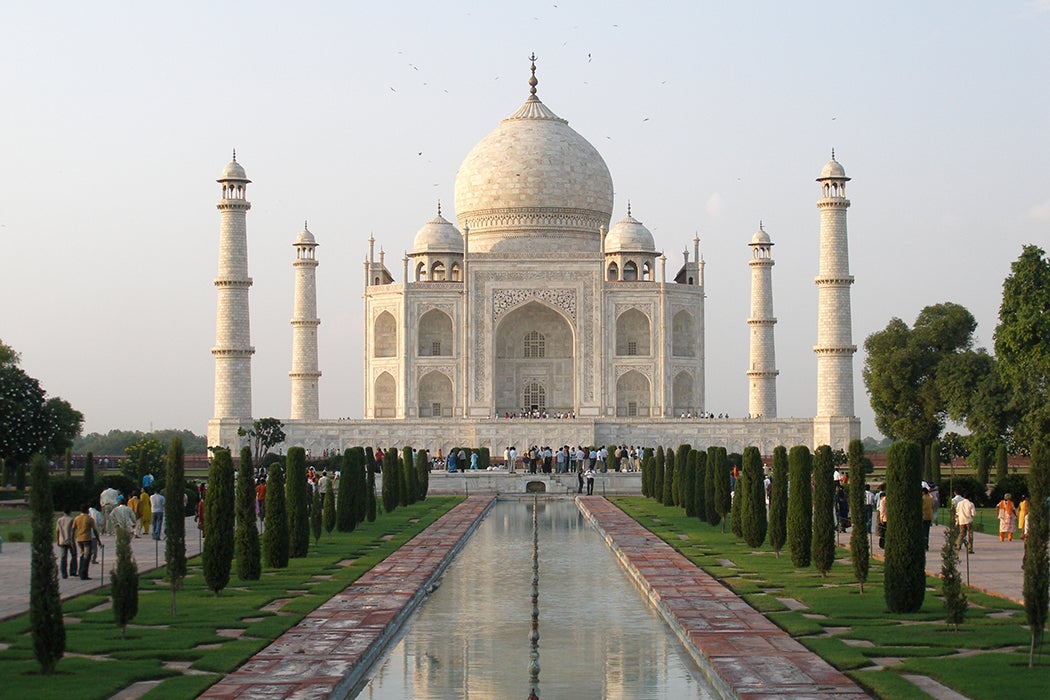A trip to the Taj Mahal is a must for any tourist visiting India. Each year, millions travel to the town of Agra in the state of Uttar Pradesh to experience the gleaming, white mausoleum. Covered with a stunning floral inlay and Quranic inscriptions, the domed marble monument is renowned for the story of love that lies at its creation; the seventeenth-century Mughal emperor Shah Jahan built the stunning tomb for his second wife, Mumtaz Mahal, when she passed away.
The Taj Mahal is easily one of the most famous and recognized Islamic buildings in the world—in the words of architectural historian Ebba Koch, the mausoleum “is the Mughals’ greatest contribution to world architecture.” But how does the Taj Mahal’s history—one that has come to visually represent the period of the Mughal Empire, an Islamic empire—sit within the narrative of a contemporary India during a period when the Hindu nationalist movement is seeking to minimize, or perhaps erase, its Islamic past?

The globally famous mausoleum is the central component and focal point of a larger complex on the right bank of the Yamuna River. The lesser recognized parts of the complex are the garden, mosque, and guest house, the latter two being identical red sandstone structures flanking the mausoleum. As political scientist Hilal Ahmed explains, the Taj Mahal has existed as a “secular” space in India since the British colonial period. In this context, the Taj Mahal seemingly has two faces: one of a historical monument and one of a religious space. Describing how those faces connect, Ahmed explains that there are
two kinds of publics—a congregation that offers prayers at the mosque, playing no attention to the central building (at least at that very moment), and a “public,” which stays at the central building and seems to follow the given official meanings of the Taj as a world heritage site.
Ahmed wonders how these publics can be reconciled. If the tomb and the mosque are “inseparable parts” of the complex, the offering of prayer can be interpreted as a “minor,” almost incidental, act. Indeed, the Muslim congregation is only allowed to gather at the mosque for Friday and Eid prayers, in addition to a few other special occasions, he notes. In its prioritized secular role, the Taj Mahal is viewed as a historical building from the past, meant to be preserved but “dead” in the sense that it “has no relation with living communities,” despite the mosque. But is this interpretation of a site identified with a legally protected religious minority ideal or even possible in postcolonial India?
As architect and historian Soumya Dasgupta describes, while the rest of the world may recognize the Taj Mahal as a distinctly Indian building, that same view is not necessarily present within India today. The Taj Mahal was omitted from a tourism brochure produced by the state government of Uttar Pradesh in 2017, and Dasgupta recognizes that moment as “the successful outcome of a long-term, consolidated effort to distort the history of the Taj Mahal as architectural heritage.” He further writes that “emergent myths, propagated through social media, have actually succeeded in formally displacing long-established academic discourse based on archeological evidence and historical studies.” Some of these myths argue that “the Taj Mahal is a Hindu temple” or that “the Taj Mahal was built by traitors.”
Other acts of diminishing India’s Islamic heritage have made headlines in recent years. In 2022, India’s National Council of Education Research and Training (NCERT) and Central Board of Secondary Education (CBSE) acted to remove chapters on Mughal history from history textbooks, greatly limiting the amount of Mughal history students in India would learn. This debate was again in the news in January 2024 when Narendra Modi, India’s current prime minister, opened the newly constructed and controversial Rama Temple in Ayodhya, Uttar Pradesh. Hindus recognize the location of the new temple as the birthplace of Lord Rama. However, it was also the location of Babri Masjid, a sixteenth-century mosque built at the beginning of the Mughal Empire. Babri Masjid was attacked in 1992 by a Hindu nationalist mob, an event resulting in riots that caused at least 2,000 deaths. Multiple court cases played out in the aftermath, and in 2019, the Supreme Court of India granted permission for a new Hindu temple to be constructed on the site, with an alternative plot designated for a future mosque.
Weekly Newsletter
So, how are we to feel about the Taj Mahal in the context of this recent history? Going back to Dasgupta’s thoughts, there’s no reason to challenge the long-standing historical documentation on the building. Built by local craftspeople with material drawn from around Asia, it’s an Islamic tomb, erected under the fifth Mughal emperor, Shah Jahan. All of this was recognized globally when the Taj Mahal became a UNESCO World Heritage site in 1983. Yet, it’s clear that the Taj Mahal’s status as a globally recognized Islamic structure conflicts with the narrative of Indian history some are trying to rewrite today.







